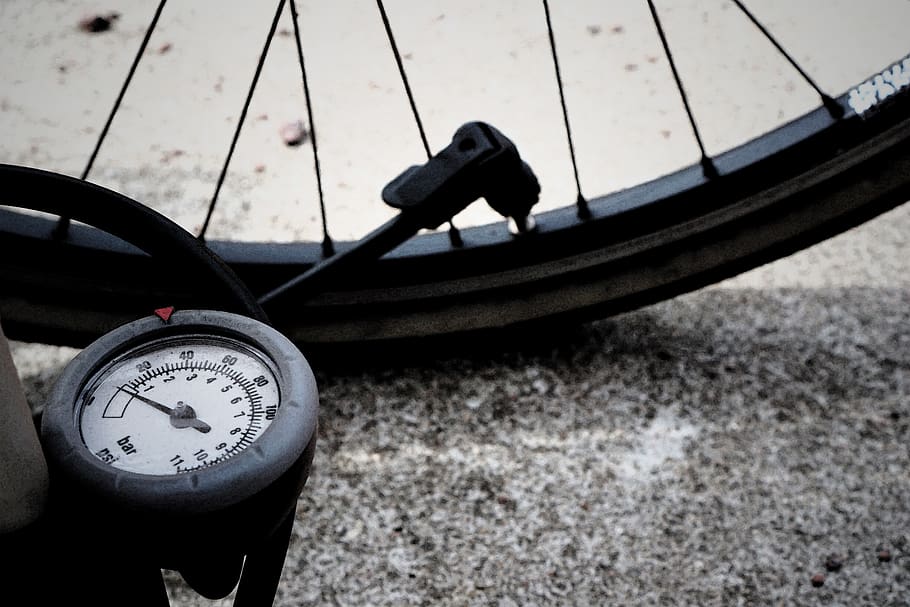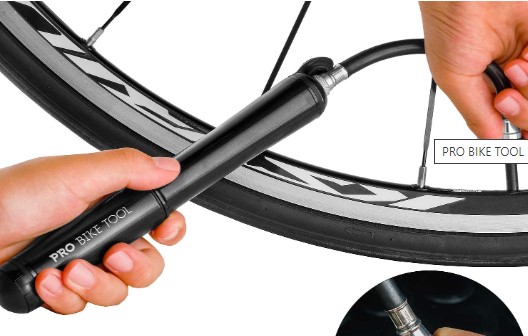Have you heard folks claim that hard inflated tires are faster than those on lower pressure? They could be theoretically right. However, what happens if you put too much air in your bike tires?
Putting too much air in your bike tire will make your off-road ride uncomfortable. In addition, over inflation could lead to tire blowouts which could result in accidents. Also, overinflated tires wear out unevenly and faster.
At the same time, putting too much air in bike tires makes your bike prone to damage as you ride through the rough surface.
What Specifically Happens If You Put Too Much Air In Your Bike Tires?
1. Rough/Uncomfortable Ride
By default, putting too much air in your bike tires makes them harder than necessary. As a result, you will have to endure the roughest ride ever.
Actually, the vibrations from the road are transmitted through the bike to you, the rider. Consequently, you will feel as if you are riding on solid steel.
2. Possible Bike Damage
On the other hand, over inflation can lead to rim and hub damage. As you ride over obstacles on the trails, or potholes and curbs on the streets, a tire with too much air won’t flex at all.
As a result, it will feel like riding on tireless rims. In such a case, the rim and the bearings could easily get damaged.
3. Increased Rolling Resistance
Did you hear someone say that riding on highly inflated tires makes them faster? Well, on perfectly smooth, hard surfaces, this could be true. Unfortunately, most of the roads aren’t as smooth.
As you ride over uneven surfaces, the tire will have so many vibrations as it ascends and descends. Also, a hard tire can’t ride over obstacles such as rocks with ease. Instead, these objects break your momentum since the tire is too rigid to get over them.
These vertical movements and obstacles will significantly increase the rolling resistance when you put too much air in your bike tires.
4. Tire Blowout And Accident
The worst thing that happens if you put too much air in bike tires is possible blowouts. The tire explodes so loud that you could temporarily lose your hearing if you were near the bike.
When there is a blowout, the inner tube typically gets torn, while the tire may also get damaged.
If a tire bursts when you are at high speed, the result could be catastrophic. Notably, you would most likely fly off the bike and land hard on the ground.
In the process, you also endanger other road users such as bikers, motorists, and pedestrians.
5. Fast Uneven Tire Wearing
If you are lucky not to get a tire burst out of over inflation, you will have to pay for it by buying a new tire soon. Actually, overinflating bike tires make the central part of the treads bulge out.
Consequently, only a tiny part of the bike tire touches the ground. As a result, the central treads wear out fast.
In addition, when you have to ride on the trails, tires with too much pressure have poor traction since they have minimal ground contact.

How Do I Know How Much Air To Put In My Bike Tires?
The results of overinflated tires can be devastating. The amount of air in your bicycle’s tires will significantly affect your ride. So, how can you tell how much air to put in your bike tires?
Getting perfect tire pressure can be a complex activity. Actually, every rider has different preferences depending on their weight, tire quality, terrain, and riding style.
All the same, putting some reasonable amount of air should be easy since most bike tire manufacturers print the max pressure on the sidewall of the tires.
Notably, the printed pressure isn’t the ideal pressure but the maximum that the wheel can handle. Without a doubt, the best pressure is several PSIs below the indicated amount.
Actually, the best practice s to inflate the tire 5-15 PSI lower than the max value and experiment by riding.
A good pump, such as the BV Ergonomic Bike Floor Pump which has a gauge, can be a great relief. Notably, it works with both Presta and Schrader valves and is ergonomically designed for comfort.
How Do I Know If My Bike Tire Is Inflated Enough?
As earlier mentioned, the ideal tire pressure for your bike is some units below the max pressure indicated on the tires’ sidewalls.
Since almost all manufacturers provide the range within which you should inflate the tire, it would be good to try something in between the recommended range.
All the same, at times, you may not have a gauge to guide you. So, how do you know that your bike tire has enough air?
If you don’t have a gauge, you can trust your hands or bodyweight for assessment. For a road bike, you need to inflate the tire to the point that you can’t easily squeeze the sides with your fingers. If you can still pinch them, you need to add some more air.
For mountain bikes, their tires operate at low pressure so, squeezing the sides with your fingers may mislead you. Therefore, the best method is to sit on your bike and see how the tire behaves.
If you see the sides of your MTB protrude more than a few millimeters, that is a sign that you need some more air. All the same, take care that you don’t overinflate the tires.

What Causes A Bike Tire To Explode?
We mentioned that a tire blowout could be dangerous. So, what causes bike tires to burst?
1. Heating Of The Rims
The leading cause of tire blowout is high temperatures that result from engaging brakes on clincher tires down a long slope. The rims get hot, and the part of the inner tube next to the rim gets heated.
Eventually, the tube and the air inside expand to the point of blowing out the tire.
2. Defective Tires
Over time, tires fatigue and can easily explode even when at rest. If the quality of the tire is compromised, inflating it to capacity could lead to a loud bang.
It is therefore advisable to regularly check your bike tires for any defects or bulges.
3. Over Inflation
The other common cause for bike tire explosion is putting too much air in the tires. The bead can only hold to a certain amount of pressure.
If the tire bead pops out of the rim, the inner tube protrudes, and due to the high pressure, it explodes like a mighty bomb.
Over inflation of tires can be fatal, and therefore, it is prudent to stick to the guidelines given by the manufacturers.
How to Fix an Overinflated Tire
It is possible to end up with an overinflated tire by mistake. So, let’s see how you can fix it in simple steps.
- Check your tire’s pressure with a pressure gauge. This will guide you on how much you need to adjust.
- If it is a Presta valve, you need first to unfasten the lock nut to allow air out. For Schrader, you skip to the next step.
- Use the rear end of the pressure gauge; push the valve center pin down the stem. This allows air to escape. Notably, please do this in short bursts as you regularly check the remaining pressure.
- Once you reach the correct/desired pressure, screw the lock nut and the cap back to the stem.
Also read:
- Why Does MY BMX Tire Wobble?
- How to put air in bicycle tires.
- Can I inflate a Presta valve with a Schrader pump?
So, what happens If you put too much air in your bike tires? Final Thought:
Technically, your ride quality would be compromised, and you risk suffering a devastating tire burst.
Fortunately, most manufacturers usually print air pressure ranges on the tire sidewalls to guide you when inflating the tires. Therefore, adhering to these directions can save you a lot of pain.
If you suspect that you have an overinflated tire, the best thing to do is slightly reducing the amount of air.